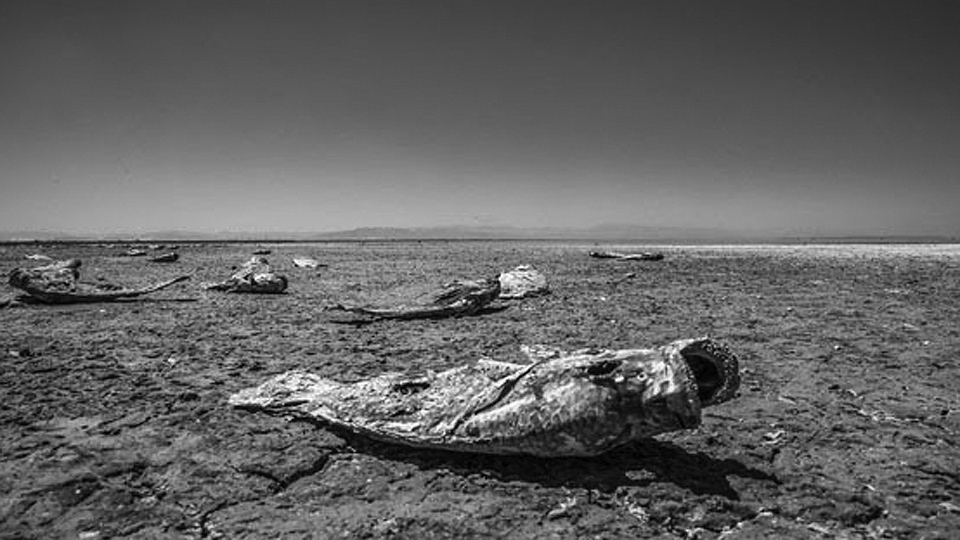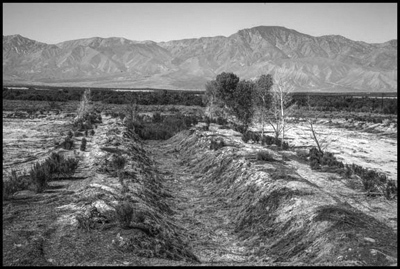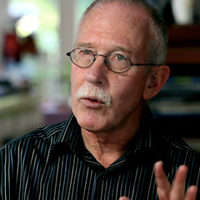
When the dust rises in North Shore, a small farmworker town at the edge of the Salton Sea, Jacqueline Pozar’s nose often starts bleeding. Her teacher at Saul Martinez Elementary School in nearby Mecca calls her mom, Maria, and asks her to come take her home.
Jacqueline is seven years old. “I feel really bad because I can’t do anything for her,” Maria Pozar says. “Even the doctor says he can’t do anything — that she’s suffering from the dust in the air. Most of the children in North Shore have this problem. He just says not to let them play outside.”
The children of North Shore are the proverbial canaries in the coal mine, whose sudden illnesses warn of a greater, life-threatening disaster to come. That disaster is the rapidly receding waters of the Salton Sea. [The Salton Sea is a shallow, saline, rift lake located directly on the San Andreas Fault, predominantly in California’s Imperial and Coachella Valleys.] As more and more playa — the sea’s mud shoreline — emerges from the water and dries out, fine particles get swept up by the wind and coat everything in their path, including children’s noses. When the airborne particles lodge in the lungs, they can cause asthma and other illnesses.
“This will be the biggest environmental disaster of our time,” charges Luis Olmedo, director of the Comite Civico del Valle, a community organization in the Imperial Valley at the Sea’s south end. “The issue of the Salton Sea trumps everything. We have to get the air contaminant level to zero. There is no safe level for the contaminants we have here. We need an intermediate project to stabilize the shoreline. The sea is receding much faster than any projects moving forward.”

Creation of the Salton Sea
The Salton seabed was created by the Colorado River millions of years ago. As it dug out the Grand Canyon, river sediment filled in a delta at the north end of the Gulf of California, creating what are now the Coachella and Imperial Valleys. Between those valleys lay an ancient geologic depression reaching a depth of 278 feet below sea level. Over the millennia it filled with water and then dried out repeatedly, but by the time of the Spanish colonization it was a dry desert saltpan.
In 1905, as Imperial Valley growers were building canals to bring Colorado River water to irrigate their farms, the levees containing their diversion failed when the river flooded. For two years the Colorado poured into the depression, creating the Salton Sea, whose surface rose over 80 feet above the desert floor.
Evaporation would eventually have dried it out, but in 1928 Congress designated land below -220 feet as a repository for agricultural runoff. Through the 1970s, the lake’s surface hovered at -227 feet, giving it an area of 378 square miles — the largest lake in California. Water from the Colorado, coming through the All-American Canal in the south and the Coachella Canal in the north, irrigated farmers’ fields and then went into the Sea, maintaining its level. Today the sediment lining the shore contains pesticides and fertilizer from decades of runoff.
The Salton Sea became a stopping point for more than 380 bird species migrating on the Pacific Flyway, including egrets, herons, gulls, eared grebes, white pelicans, Yuma clapper rails and gull-billed terns. The sea was stocked with fish species including corvina, sargo and bairdella. Tilapia introduced to control algae in irrigation canals also wound up in the lake.
Over the years the Salton Sea’s salinity increased, however, from 3,500 parts per million to 52,000 ppm – about 50 percent saltier than the ocean. Fish, except the tilapia, died off. Phosphorus and nitrogen from fertilizers, and nutrients stirred up by winds from the sea’s bottom, now create algae blooms that deplete oxygen, kill fish and contribute to diseases that kill birds. In 2012 the terrible stench from one algae bloom smothered Los Angeles for days, demonstrating that wind-borne dust may potentially travel that far as well. It can also blow south – across the border into Mexicali, Baja California’s capital city of more than 650,000 people.
In 2003 California was forced to reduce the water it takes from the Colorado to legal limits. As a result of an agreement hammering out how it would be shared, water began to be transferred from the Imperial Valley to San Diego. California Rural Legal Assistance warned the state plan “fails to comply with the California Environmental Quality Act.” At first valley growers agreed to fallow some fields, and the saved water continued to flow into the Sea. But this year fallowing ends, and water transfers to San Diego will rise sharply in December.
Farmworkers and families suffer
The California Natural Resources Agency says, “Inflow to the Salton Sea is expected to shrink significantly after 2017, when water transfers from the Imperial Valley accelerate and mitigation water deliveries stop under agreements reached years ago.” The 2003 agreement said the state would pay to restore the environmental health of the Sea, but for 13 years no money was appropriated. Imperial County, its air pollution district and local growers tried to challenge the agreement in court, but lost.
According to a 2005 Border Asthma and Allergies (BASTA) Study conducted by the California Department of Public Health, 20.2% of children in Imperial County are diagnosed with asthma. The national average is 13.7%. Imperial County consistently has the highest asthma hospitalization rates among all California counties, and ten valley residents died of it from 2000 to 2004.
Not all asthma is due to dust from the Sea. Even smaller particles, called PM 2.5, come from smoke from burning fields after crops are picked. The Comite Civico has pushed for banning field burning for many years, but “it’s cheaper for farmers to burn,” says Humberto Lugo, a Comite Civico staff member. “There’s no way to know exactly how much pollution is due to the Salton Sea. But we can say that peoples’ problems are aggravated when the dust blows from the shoreline. My son in Calipatria [an Imperial Valley farmworker town very close to the shore] comes out to play baseball with a glove on one hand and his inhaler in the other. I can see this problem in my own family.”

Calipatria, North Shore and the other towns around the sea are among the poorest in California. While California’s unemployment rate is a about 5%, the Imperial County’s rate is four times greater. Over 23% of the Imperial Valley’s 177,000 residents (over 80 percent of whom are Latino) live in poverty.
”The wealth of the agricultural industry has been built on top of the suffering of generations of farm workers, from direct abuses in the fields to degradation of the land and environment,” says Arturo Rodriguez, president of the United Farm Workers. “Nowhere are the hardships farm workers and their families endure more conspicuous today than with dust pollution from the Salton Sea. What good does it do farm workers to win better pay and benefits when their health is crippled because of where they live and work?”
Organizations like Comite Civico and the Leadership Counsel for Justice and Accountability have pushed to put health concerns on the agenda for the state hearings about mitigating the impact of the water transfers. Over the last few years the Comite has put air monitors in over 40 sites, training community residents to understand their use. Many schools now fly flags when the monitors indicate dust storms or severe air contamination, warning students to stay indoors.
The Torres Martinez tribe
And for the first time, the state has budgeted $80 million for remediation, some of which goes to the Torres Martinez tribe at the north end of the lake. They’ve begun creating new wetlands on their reservation, which lies next to the shoreline – some of it even under the water. The tribe’s survival depends on rescuing their land. According to Alberto Ramirez, in charge of the project, “For the Torres Martinez, there’s nowhere else to go. What we have – this is it.”
Of the tribe’s 800 members only 300 still live on the reservation. Half of them have respiratory illness. “The most important reason for this project is recovering the health of the community,” he adds.
Oral histories and songs preserve the Torres Martinez’ memories of earlier historical eras, in which water filled the basin and people would migrate from the lake’s edge to the surrounding mountains and back. Now only five people speak their indigenous language, however. “But we have the ability to resist,” explains Mike Mirelez, cultural resources director. “If we have better living conditions our tribe will become more self sufficient. With more resources we can set up after school programs for our kids, work towards revitalizing our language, and teach them how to grow food.”
Near the shoreline, the tribe’s skiploaders move earth to create ponds for fish, and cascading pools and furrows to anchor native plants. They are creating a model. It only occupies a small part of an immense shoreline. To replicate it around the sea, and bring the water to make it thrive, would take not millions, but billions of dollars.
Ramirez believes that will be a long fight, “but we have to figure out how to adapt to survive, and the tribe has been doing this for generations.” Comite Civico’s Olmedo knows it will be a long fight too. “We should slow down the water transfer and make sure there’s no water transfer without full mitigation,” he urges. “Full mitigation means that there will be no new environmental exposure that threatens health. We have to keep the hazardous soil in the ground. San Diego should use all its available resources before pulling water from here. We should be an emergency resource, not a day to day water source.”

According to Eduardo Garcia, the Imperial Valley’s representative in the California State Assembly, “Our challenge is to cover up those [exposed] areas, to build habitat as fast as the sea recedes. That is the only option. The state’s commitment is through a 10-year management plan to mitigate the public health impacts. It [$80 million] is enough to create a management plan, but it’s not enough to restore the Salton Sea. We have to get the money we need to implement the rest of the plan. We’re going to ask the Governor to fund the plan in its entirety. We need him to come through for us here in Imperial County. We need the money.”
In the meantime, Maria Pozar and her children, and her neighbors in North Shore, have no plans to leave. “We’re all poor people, living here because we work in the fields. My husband has a stable job and my whole family is here. We’re going to spend our lives in North Shore. We can’t move. Our kids are growing, and Jacqueline has all her friends here. I have a new baby. Now I wonder if he will have asthma too.”










